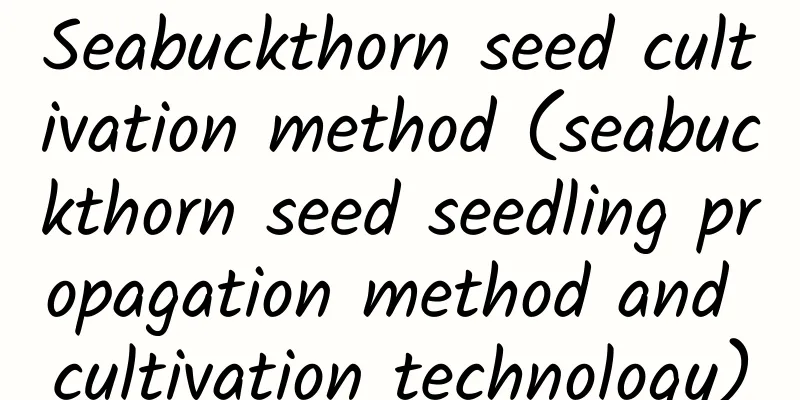Seabuckthorn seed cultivation method (seabuckthorn seed seedling propagation method and cultivation technology)

1. Key points of seabuckthorn seedling cultivation technologySeabuckthorn cultivation technology is mainly divided into three stages: sowing, seedling planting and strip sowing. 1. PlantingDuring the sowing stage, Haidong City mainly selects suitable seed growing areas, such as barren areas in barren mountain areas for sowing. The sandy soil in these areas is more suitable for sea buckthorn planting. Local people generally choose to sow in April or May, or at the end of August after the local rainy season. The local sea buckthorn sowing density is 2 kg/650 m2, and sufficient irrigation is required for sowing. Some local forest areas also use direct sowing methods, such as the hole sowing method, which digs shallow pits with a diameter of 40 cm and a depth of 30 cm, and sows 6 seeds in each shallow pit. Locals choose mixed planting, that is, combining different sea buckthorn varieties to ensure good results in the future. 2. Planting seedlingsWhen planting seabuckthorn on arid slopes, Haidong City generally selects trees that are 1-2 years old, 30-100 cm tall, and with a root length of more than 20 cm for large-scale planting. This can ensure that the survival rate of seedlings is higher and the effect is better. In the process of planting seedlings, it is necessary to avoid the phenomenon of seedling roots being buried, and also pay attention to the mixing of seeds, which are generally matched according to the planting ratio of 7:3. 3. CuttingsCuttings refer to the cutting stage of sea buckthorn. Local people choose to do cuttings in spring and autumn, and generally choose areas with abundant water for cuttings. The specific method is to make cuttings of about 10 cm, remove excess leaves (retain 4-6 leaves), disinfect the cutting position, and then soak the cuttings in clean water for about 5 days. The soil in the planting area should be turned over and dried to help reduce bacteria in the soil. In the final cutting stage, the cuttings need to be inserted into the soil to a depth of about 25 cm. Haidong City has chosen the correct planting technology, basically following the planting method of shallow seedling holes, root nesting, and multiple plants in one hole. The rational application of these technical methods can effectively affect the survival rate of sea buckthorn. During the seedling planting process, the main thing is to ensure that the seedlings are in the right position, the stems are straight and the roots are stretched out. Based on the actual situation, choose loose soil to cover about 5-10 cm and ensure that the seedlings are planted deeply and firmly. On the basis of ensuring standardized sea buckthorn planting technology, we use measures such as water-retaining agents and rooting powder to optimize it, create good conditions for sea buckthorn, and achieve remarkable results. 2. Key points of seabuckthorn cultivation management and technologySea buckthorn management mainly revolves around the following two points. ① First of all, we need to strengthen the management of seedlings. Local professional technicians will carry out maintenance work on seabuckthorn, including blocking and reducing human and animal activities to avoid damage to the seedlings. The seabuckthorn seedlings will be enlarged and weeded at regular intervals to ensure a good living environment for seabuckthorn and provide sufficient growth nutrition space for growth. ② Secondly, we need to strengthen the prevention and control of seabuckthorn diseases and insect pests. Seabuckthorn itself has good resistance to diseases and insect pests and is less affected by them. At present, the main disease and insect pest of seabuckthorn is damping-off disease, so we need to effectively prevent and control this disease. ③ In addition to the above contents, sea buckthorn management should also focus on the effective prevention and control of rats, rabbits and insect pests, and adopt the management method of loosening soil and weeding to adjust the space of sea buckthorn on the slope and implement replanting. |
Recommend
The legend of Astragalus
Legend 1 A long time ago, during the Qing Dynasty...
Can figs be pruned in summer? When is the best time to prune?
Fig tree pruning has many functions. Generally sp...
Can cherry trees be planted in Hunan?
Can cherry trees be grown in Hunan? Cherry trees ...
Nine taboos of drinking honeysuckle in water
Avoid overdose Honeysuckle is cold in nature, and...
Breeding methods and precautions of wooden unicorn
1. Breeding methods 1. Soil: It is best to choose...
The difference between Magnolia grandiflora and Magnolia grandiflora
the difference First of all, I would like to popu...
What flowers to send for your wedding anniversary
Wedding anniversaries are created to cherish love...
How to grow jade pendants so that they can bloom to full bloom?
Jade pendant is also called jade ornaments, jade ...
Diseases and prevention methods of Cercis chinensis
Diseases of Bauhinia: Angular leaf spot symptom A...
Is agave poisonous? Can it be grown at home?
Is agave poisonous? Agave is a poisonous plant in...
Is it profitable to grow Ganoderma lucidum? Profits and prospects of growing Ganoderma lucidum
Can you make money by growing Ganoderma lucidum? ...
The reason why the back of the camellia leaves turn yellow and curl a little
1. Low temperature Reason: Camellia trees cannot ...
What fertilizer should be used for jujube trees to make them big and sweet? What fertilizer should be used for jujube seedlings to make them grow fast and bear more fruits?
If we want to grow big and sweet jujube trees, fe...
How to change the pot of Goldfinger
Repotting Goldfinger: Preparing the soil Generall...
How to grow ginger lotus
1. Maintenance methods 1. Temperature: The most s...









